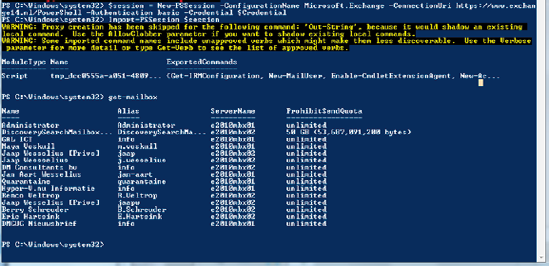4 Remote PowerShell
The Remote Shell
is new in Exchange Server 2010, making it possible to connect to an
Exchange Server 2010 server at a remote location. The workstation
doesn't have to be in the same domain or even have the Exchange
Management Tools installed – as long as the proper credentials are used,
it will work. With this kind of functionality, it's now as easy to
manage your Exchange Servers in another part of the building as your
Exchange Server in a datacenter in another part of the country.
When the Exchange Management Shell is opened via Start Menu> All Programs> Exchange Server 2010,
the Exchange Management Shell will automatically connect to the
Exchange Server 2010 you're logged on to. But using the remote options,
it's also possible to connect to a remote Exchange Server at this stage.
To use the Remote Shell, you'll need to log on to a
Windows Server 2008 (R2) server or Windows 7 workstation that has the
Windows Management Framework installed. The Management Framework
consists of PowerShell 2.0 and Windows Remote Management (WinRM) 2.0,
and can be downloaded from the Microsoft website: HTTP://TINYURL.COM/POWERSHELL2
Make sure that the workstation (or server) supports
remote signed scripts. Due to security constraints, this is disabled by
default. You can enable this support by opening a Windows PowerShell
command prompt and entering:

The next step is to create a session that will
connect to the remote Exchange Server. When the session is created it
can be imported into PowerShell:

The PowerShell on the workstation will now connect to
the remote Exchange Server using a default SSL connection and,
RBAC-permitting, all Exchange cmdlets will be available. It's incredibly
easy.

To end the remote PowerShell session, just enter the following command:

Admittedly, the above example is from a server that's
also a member of the same Active Directory Domain. To connect to a
remote Exchange Server 2010 server that's available over the Internet,
multiple steps are required. The first step is to create a variable in
the PowerShell command prompt that contains the username and password
for the remote session:

A pop-up box will appear, requesting a username and
password for the remote Exchange environment. Once you've filled in the
credentials, the following command will create a new session that will
setup a connection to the Exchange environment. The $Credential variable
is used to pass the credentials to the Exchange environment, and then
the session is imported into PowerShell:


NOTE
If you want to connect
to a remote Exchange Server 2010 server over the Internet you have to
remember to enable Basic authentication on the remote server. Open the
Internet Information Services (IIS) Manager on the server, navigate to
the Default Website and select the /PowerShell Virtual Directory. In the
results pane, under IIS double-click on Authentication. Here you can
enable Basic Authentication.
The examples were for the Active Directory Domain
Administrator, who automatically has the remote management option
enabled. To enable another user for remote management, enter the
following command:
